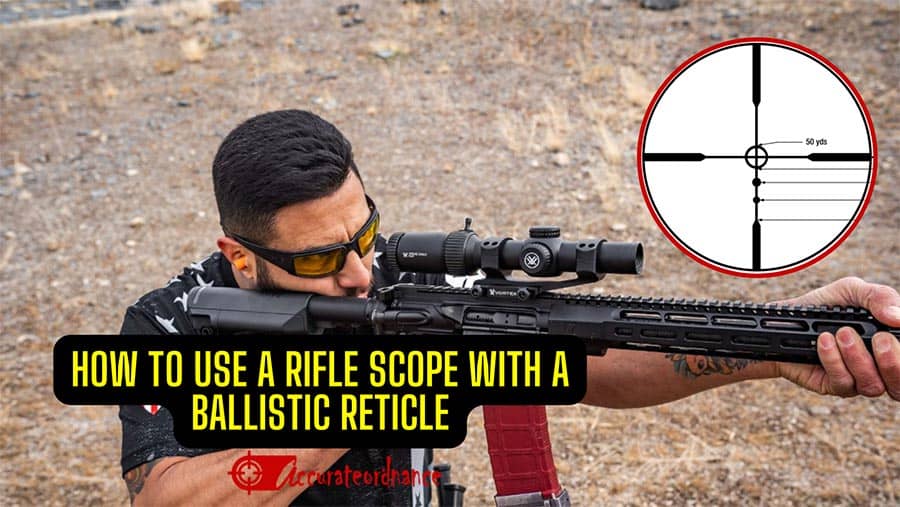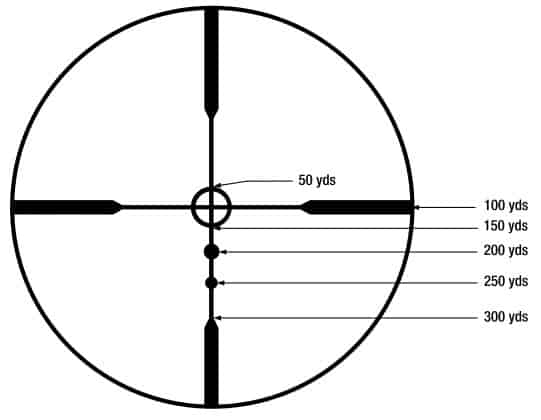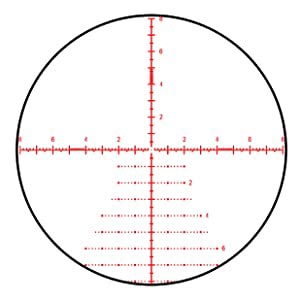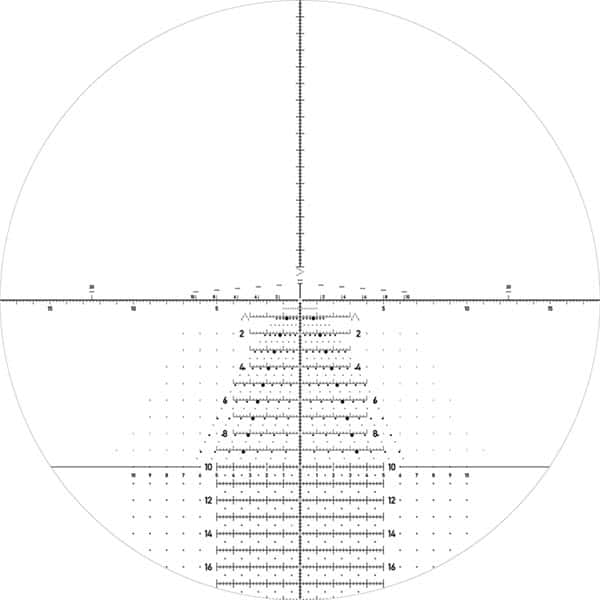Are you looking for a guide on how to use a ballistic reticle? Jump in; let’s unravel this mystery! Shooting with a riflescope that is equipped with a ballistic reticle can significantly enhance your hunting and shooting experience. The ballistic reticle is a type of reticle that allows for precise shots at various ranges without adjusting the scope’s settings. However, many people do not know how to properly use a scope with this type of reticle, and this can result in missed shots.

In this article, we will provide a comprehensive guide on how to use a rifle scope with a ballistic reticle effectively. From understanding the basics of the ballistic reticle to selecting the right scope and setting it up correctly, we will cover everything you need to know. Whether you are a beginner or an experienced shooter, this guide will help you take your shooting skills to the next level. So, let’s dive in and learn how to use a ballistic reticle like a pro!
Definition of a ballistic reticle
A ballistic reticle is a type of reticle used in riflescopes that helps shooters make accurate shots at various distances without the need to adjust the zero of the scope for that shooting distance. Unlike traditional crosshairs, which are fixed and do not change, a ballistic reticle has a set of markings specifically designed to correspond to the bullet’s trajectory. The markings can be in the form of dots, lines, or other symbols that allow the shooter to compensate for bullet drop, wind drift, and any other environmental factor that can affect accuracy.

Each ballistic reticle is unique and calibrated to match the ballistics of a specific cartridge or load. When using a ballistic reticle, the shooter must know the distance to the target and select the appropriate marking on the reticle that corresponds to that distance. By aligning the crosshairs with the appropriate marking, the shooter can aim accurately and increase the chances of hitting the target.
Ballistic reticles are commonly used by long-range shooters who need to make precise shots at varying distances. They can also benefit tactical shooters who need quick target acquisition and accurate shots in high-pressure situations.
Understanding the reticle’s markings
The reticle markings and measurements are crucial for using a ballistic reticle scope effectively. Here’s a breakdown of the most common markings and measurements found on ballistic reticles:
Hashmarks
Hashmarks are the most common markings found on a ballistic reticle. They are typically spaced evenly along the horizontal and vertical axes of the reticle and are used to compensate for bullet drop and windage. The spacing between the hash marks represents a specific distance, such as 100 yard or 200 yard. By adjusting the windage and elevation turrets, the shooter can align the hashmarks with the target and make an accurate shot.
Dots
Dots are another common reticle marking used for aiming. They are similar than hashmarks but are represented by a single dot. Dots are often used for short-range shooting and are typically spaced at shorter intervals.
Types of ballistic reticle
There are several types of ballistic reticles available, each with its own unique design and purpose. Here are some of the most common types of ballistic reticles:
Mil dot Reticle
The mil dot reticle is a ballistic reticle that features small dots spaced at precise intervals, usually one milliradian apart. These dots can be used to estimate the distance to a target and compensate for bullet drop. This type of reticle is commonly used for long range shooting and tactical applications.
BDC Scope (Bullet Drop Compensation)
A BDC scope reticle is designed to compensate for bullet drop at specific distances. It features a series of marks corresponding to different distances and calibers, allowing for more precise adjustments. This reticle is usually used for long-range shooting.
Christmas Tree Reticle

The Christmas tree reticle is a type of mil-dot reticle that features additional horizontal and vertical lines that resemble the branches of a Christmas tree. These lines can be used to compensate for wind drift and bullet drop at a longer distance. This type of reticle is commonly used for long range shooting and tactical applications.
Horus Reticle

The Horus reticle is a type of mil-dot reticle that features a complex grid of dots, lines, and hash marks. It is designed to provide precise aiming points at different distances and compensate for bullet drop and wind drift.
Advantages Of A Ballistic reticle
Ballistic reticles offer several advantages over traditional crosshair reticles. Let’s take a closer look at each of these advantages:
Eliminates the need for frequent scope adjustment
One of the primary advantages of ballistic reticles is that they allow shooters to compensate for bullet drop at different distances without having to frequently adjust the settings on the scope. Traditional crosshair reticles require shooters to adjust the scope’s elevation turret to compensate for bullet drop at varying distances. This process can be time-consuming, especially when hunting or shooting at moving targets. With a ballistic reticle, shooters can simply use the markings on the reticle to adjust their aim without having to touch the scope’s windage and elevation settings.
Provides multiple aiming points
Another advantage of ballistic reticles is that they provide multiple aiming points corresponding to different distances. This means that shooters can make more precise shots without estimating holdover or adjusting the scope’s settings. For example, a BDC reticle may have markings for 200, 300, and 400 yards, allowing the shooter to quickly adjust their aim for each distance without manual adjustments.
Improves accuracy
Ballistic reticles can improve the accuracy of shots taken at varying distances by providing aiming points in the form of dots and lines. Shooters can more easily and quickly adjust their aim, which means they can make more accurate shots quickly. This reticle is important when hunting, where a missed shot can mean losing the opportunity to take down a game animal.
Offers versatility
Ballistic reticles can be used for a wide range of shooting applications, from hunting to tactical shooting to long-range shooting. This means that hunters and shooters can use the same rifle and scope for different types of shooting without changing the scope or making other modifications.
Save time
Ballistic reticles can save time in several ways:
- Faster target acquisition
A ballistic reticle can help you quickly acquire a target and make an accurate shot when shooting at longer ranges. This can save you time compared to using a standard crosshair reticle, where you might need to make multiple adjustments to line up your shot.
- Fewer adjustment
With a ballistic reticle, you can use the markings on the reticle to compensate for bullet drop and windage, reducing the need for adjustments to the windage and elevation turrets. This can save you time when making shots at different distances or in varying wind conditions.
- No need for external devices
Ballistic reticles can eliminate the need for external devices like rangefinders or wind meters, which can save you time setting up and using these tools.
- Pre-set holdovers
Many ballistic reticles have pre-set holdovers or aim points for specific distances, allowing you to quickly adjust your aim without having to calculate holdover or make adjustments to your scope.
Setting up a Ballistic Reticle Scope
Setting up a scope with a ballistic reticle might seem intimidating, but it’s a straightforward process just like every other kind of scope. Here’s how to set up a rifle scope with a ballistic reticle:
Mount the Scope
The first step is to mount the scope on the rifle. Ensure that the scope is securely attached to the rifle using the appropriate mounting hardware. A properly mounted scope will ensure stability and minimize the amount of movement or shift that may occur during shooting.
Zero the Rifle
After boresighting, zero the rifle by firing a group of shots at a target. Choose a target at a known distance and fire a group of shots at the center of the target. The group should be as tight as possible. After firing the group, adjust the windage and elevation turrets to move the reticle to the center of the group. Repeat the process until the reticle is centered on the point of impact. This step will ensure that your rifle is accurately sighted in.
Determine the Ballistic Drop
Determine the ballistic drop of your rifle and ammunition by using a ballistics calculator or consulting a ballistics chart. These tools will give you the necessary information to adjust your reticle for bullet drop at various distances. You will need to know the muzzle velocity of your ammunition, the bullet weight, and the ballistic coefficient to calculate the bullet’s trajectory.
Adjust the Reticle
After determining the ballistic drop, adjust the reticle by using the windage and elevation turrets. Most ballistic reticles feature markings that correspond to different distances, making it easy to adjust for bullet drop. Adjust the reticle to match the bullet drop at the desired distance. For example, if the ballistics chart tells you that the bullet will drop 10 inches at 500 yard, you will need to adjust the reticle accordingly.
Practice
Practice shooting at different distances and environmental conditions to familiarize yourself with the reticle and its functions. The more practice you get, the more comfortable and confident you’ll become with using the scope and its ballistic reticle. Shooting in different conditions, such as wind or rain, will help you understand how the reticle works and how to adjust it for different situations.
Shooting with a ballistic reticle: Tips and tricks
A ballistic reticle can be a bit challenging than a standard crosshair reticle, but with some practice and a few tips and tricks, you can make accurate long distance shots. Here are some tips for shooting with a ballistic reticle:
Know your rifle and ammunition
Before using a ballistic reticle, you need to know your rifle and ammunition inside and out. The reticle is calibrated to work with a specific bullet weight, velocity, and barrel length, so make sure you know the ballistics of your setup to make accurate shots.
Use the right magnification
A ballistic reticle can be used effectively at different magnification levels, but a higher magnification setting is typically required for longer distances. Adjust the magnification to the appropriate level for the distance you are shooting.
Don’t rush your shots:
Shooting with a ballistic reticle requires patience and concentration. Set up your shot correctly, align the reticle with the target, and ensure you are using the correct holdover or compensation.
Practice, practice, practice
Using a ballistic reticle requires practice and experience to master. Spend time at the range shooting at different distances and in different conditions to get a feel for how the reticle works and how it interacts with the bullet trajectory.
Factors to consider when selecting a scope with ballistic reticle
Selecting a riflescope with a ballistic reticle can be a daunting task, as there are many different options available on the market. Here are some important factors to consider when selecting a rifle scope with a ballistic reticle:
Magnification Range
Magnification change in a riflescope refers to the ability to adjust the scope’s zoom level to get a closer look at a target. A higher magnification range allows for more precise aiming, especially at longer ranges, but can make it more difficult to acquire targets quickly at closer ranges. Consider the type of shooting you plan to do when selecting a magnification range. If you plan to do long-range shooting, a higher magnification range may be necessary, whereas if you plan to hunt, a lower magnification range may be more appropriate. Generally, when you zoom into a ballistic reticle scope, you will see the dots and lines clearly, and it would be easier for you to place the particular line on your target.
Reticle Type
There are several types of ballistic reticles available, including BDC (bullet drop compensation) reticles, MOA (minute of angle) reticles, and MIL (milliradian) reticles. A BDC reticle feature markings that correspond to different distances, allowing for quick and easy adjustments to aim for bullet drop and wind drift. MOA and MIL reticles use angular measurements to make precise adjustments. Consider the type of shooting you plan to do, the ranges you’ll be shooting at, and your own personal preference when selecting a reticle type.
Quality of Glass
The quality of the glass used in a scope is an essential factor to consider when selecting a scope with a ballistic reticle. High-quality glass can significantly impact the clarity and brightness of the image, making it easier to see targets and aim accurately. Look for scopes with high-quality glass and lens coatings that provide clear and bright images, even in low-light conditions.
Budget
The cost of a scope can vary greatly, with high-end models costing thousands of dollars. Consider your budget when selecting a ballistic reticle scope, and look for a scope that provides the features and performance you need within your budget. Remember that a higher price does not always equate to better performance, and it’s essential to prioritize features that are most important to your shooting needs.
Durability
The durability of a scope is another critical factor to consider. A durable scope is essential for hunting or tactical shooting, where the rifle is exposed to harsh environmental conditions. Look for scopes made from high-quality materials, such as aircraft-grade aluminum that can withstand the rigors of outdoor use. Additionally, consider factors such as shock resistance and waterproofing, which can impact the overall durability of the scope.

Mike Hardesty is a published freelance gun writer. He also possesses specialized expertise in rifle scopes With dozens of articles and reviews published in Pew Pew Tactical, Snipercountry.com, and TTAG (The Truth About Guns), Mike is considered a firearms expert. His special area of expertise is handguns.
Mike is a long-time shooter. He has been punching paper targets, taking deer and other game and shooting at competitions since about 1975. Other related pursuits include reloading and bullet casting. He currently reloads for over 10 calibers, both handgun and rifle. His reloads, particularly for 9mm, were in great demand during the height of the ammo shortage among family and friends. He donated hundreds of rounds to informal shooting sessions. He was quoted as saying “I do not sell my reloads but I sure will help my guys shoot ’em for free!”. He has a few cherished firearms that he has inherited or otherwise procured — those are his favorites.
He earned B.S. and M.S. degrees from Indiana State University in 1974-1975.
He’s a firearm experts and is the founder of mhardesty.com.
